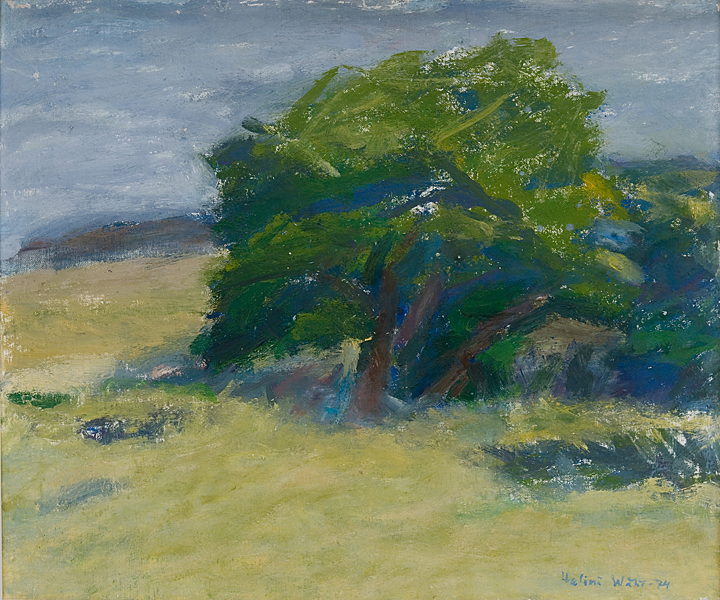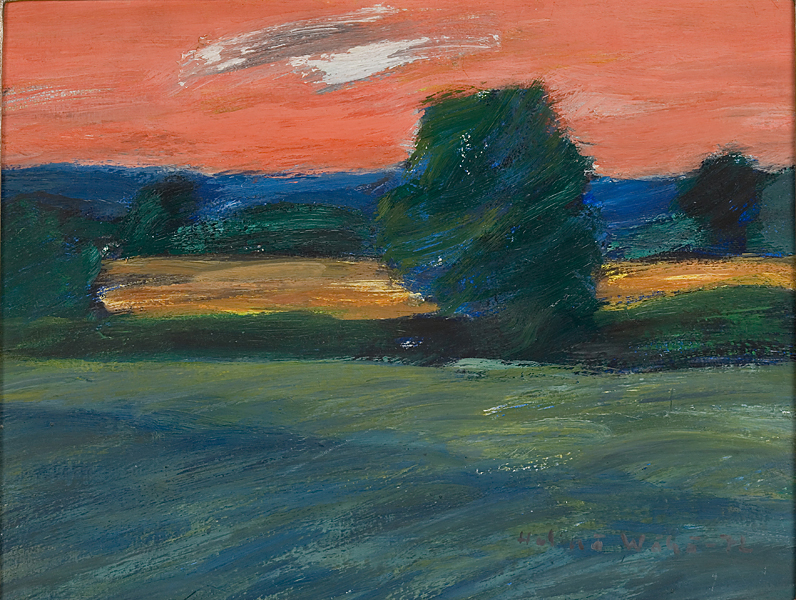FOKUS Helinä Wähä
Meditating landscapes
8.9.–5.11.2023


The FOKUS exhibition series at the Aine Art Museum displays works by Helinä Wähä (1925–2013) from the collection of the Aine Pictorial Art Foundation and from a private collection.
Helinä Wähä was born in Käpylä, Helsinki, in 1925 and continued to live there all her life. She was born to a family of painters. Her father was artist Seth Joel Wähä (1888–1958) and her paternal grandfather was decorative painter Johan Petter Wähä, born in 1863 in Alatornio, Lapland. Even though Helinä Wähä was born and bred in Helsinki, she cherished her connections with Northern Finland, and so Veli Aine, a prominent businessman with an honorary title, later acquired three of her paintings for his private art collection in Tornio. The Aine Pictorial Art Foundation also features Tornio landscapes painted by Helinä Wähä’s father.
Already as a child, Helinä loved to draw. Her artist father is said to have encouraged his daughter and was so proud of her that he sent a drawing by the five-year-old Helinä to a major Finnish daily, which agreed to publish it. A drawing that Helinä made while in primary school attracted attention. It was sent by teacher Engun Rauhamaa to be displayed at an art exhibition in Tallinn, Estonia. Helinä Wähä thus participated in her first international exhibition in 1938, at the early age of 13. In secondary school, Wähä was taught by Matti Warén, scenographer at the Finnish National Theatre, who was so excited about her drawings that he showed them to many of his fellow artists. Helinä Wähä has said that since her childhood she observed the variations of light and shadow, the play of sunrays on the patterns of rugs and the shape of a window cast on the floor. Wähä’s strongly personal world of visual experiences can also be seen in her later works.
After the wartime, Helinä Wähä started her art studies in 1943 at the evening school for drawing of the Finnish Art Society at the Ateneum, Helsinki, working as a clerk for the National Board of Railways during the day. She continued her art studies at the Ateneum until 1946, when she moved on to the Finnish Art Academy School. Wähä has cited Aarre Heinonen and Olli Miettinen as her most important teachers. At the Ateneum, today Finland’s largest art museum, her closest fellow students and peers included the Finnish artists Rafael Wardi, Viktor Kuusela and Stig Fredriksson. Denmark became an important location for Wähä, who studied at the Charlottenborg Academy of Arts in Copenhagen from 1958 to 1960. Later on, she used to spend summers in Denmark.
Helinä Wähä held her first solo exhibition in Helsinki in 1951. It was followed by a number of group and solo exhibitions in Finland and abroad. Since 1957, Wähä regularly participated in exhibitions by the Artists’ Association of Finland and the Finnish Painters’ Union. She also held exhibitions in Denmark and in Paris, among others. The main exhibitor for her works became the Taidesalonki Art Gallery in Helsinki, which was run by Leonard Bäcksbacka, and Wähä’s art was regularly displayed there. Her delicate landscapes and sophisticated use of colours attracted attention early on. Wähä often painted her immediate surroundings: her native Käpylä neighbourhood and the streets of Helsinki, and also views from the archipelago of Turku and the Ostrobothnia region. In 1966, the art critic Tuuli Reijonen of the main Finnish daily, Helsingin Sanomat, described Wähä as a well-known portrayer of the city, who seems to have fused with the barren world of houses and streets as if she knew it intimately. Wähä always depicted landscapes in a concentrated style. Her manner of portraying the urban milieu was described in contemporary criticism as a poet’s sensitivity that made the grey walls of buildings in Helsinki almost flow with the southern light. “Wähä’s city is never gloomy, it is airy and beautiful,” critic Tuuli Reijonen wrote in Helsingin Sanomat in 1968.
The collection of the Aine Pictorial Art Foundation has three oil-painted landscapes by Helinä Wähä from the 1970s and 80s. Midsummer night (1972), Oaktree (1974), and Junipers by the shore (1985) all testify to Wähä’s sensitive skill of reducing the subject to the essential. They also show her soft, almost hazy use of colours that has even been described as ethereal. In contemporary criticism, her works were often compared with those of the Finnish painter Ragnar Ekelund. Like Wähä, Ekelund was known for depicting the urban milieu and streets in a gentle way. Wähä’s art was also seen relate to the style of another colourist, the Finnish painter Sigrid Schauman. A critic for the Swedish-language daily in Finland, Hufvustadsbladet, wrote in 1978 that Wähä paints beautifully and in green just like Schauman, but in her own style. Yet in interviews Helinä Wähä named as her most important influences Titian’s painting Venus with a Mirror at the Ca’ d’Oro in Venice and the works of Pierre Bonnard and other impressionists.
The FOKUS exhibition moreover displays Wähä’s works from a private collection. The oil painting Self Portrait from 1956 shows the determined look of the artist and her gentle colour palette. An etching from 1969 depicts the wintry streets and wooden houses of Wähä’s own Käpylä neighbourhood. While the oil painting entitled Hietaniemi chapel is signed in the year 1975, a work with the same name was displayed at Gallery Hörhammer in Helsinki as early as 1964 at Wähä’s solo exhibition showing a total of 35 works. It is not known whether it is the same work. For the Hörhammer exhibition, Wähä was commended for the fragile sensitivity and sophisticated colour harmonies of her paintings.
Whereas Helinä Wähä was an artist who actively displayed her work, very little information on her private life has been preserved for later generations. In contemporary interviews, she is often described as a slightly mysterious, dark-browed artist whose narrow choice of themes reflects a certain severity of spirit and restricted choice of artistic means.
In 1978, the art critic of Helsingin Sanomat Markku Valkonen noted: “Wähä’s landscapes suggest something beyond a landscape; they convey the sensation of a landscape”. Throughout her life, Wähä continued to paint landscapes and her interpretation of them.
The FOKUS exhibition series now introduces the works of Helinä Wähä probably for the first time in the history of the Aine Art Museum. Along with the collection of the Aine Pictorial Art Foundation, Helinä Wähä’s works can be found in a number of major Finnish art collections, including those of Amos Andersson, Bäcksbacka, Nelimarkka Museum, Pori Art Museum, Maire Gullichsen, the Saastamoinen Foundation, the cities of Helsinki and Lohja, as well as the Finnish State Art Collection.
Amanda Hakoköngäs, Curator